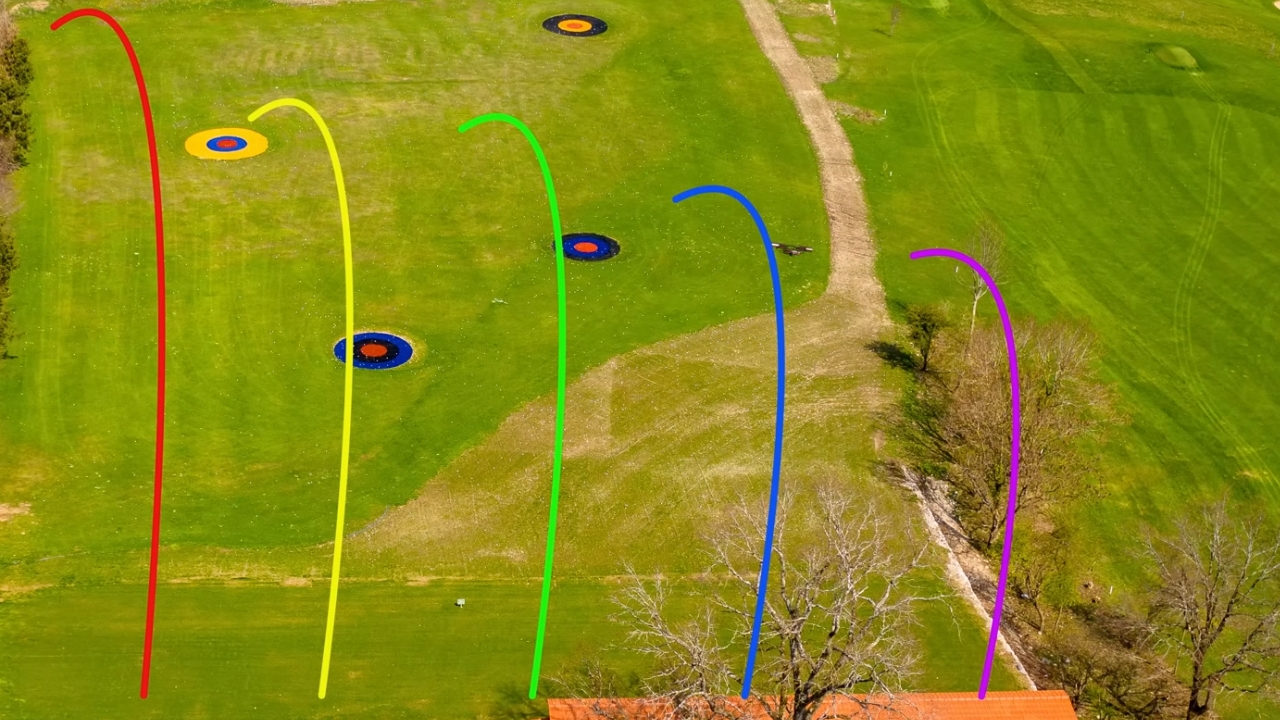Golfers often wonder how their hitting distances stack up against others. Knowing the variations due to age, gender, and skill can prevent unrealistic comparisons.
Key elements such as swing speed, ball speed, and smash factor significantly impact how far each club can drive the ball.
Additionally, the quality and optimization of equipment play crucial roles.
Physiological factors like age, strength, and flexibility levels also contribute, and improvements in these areas can be achieved through training or coaching.
Golf Club Distance Chart by Swing Speed
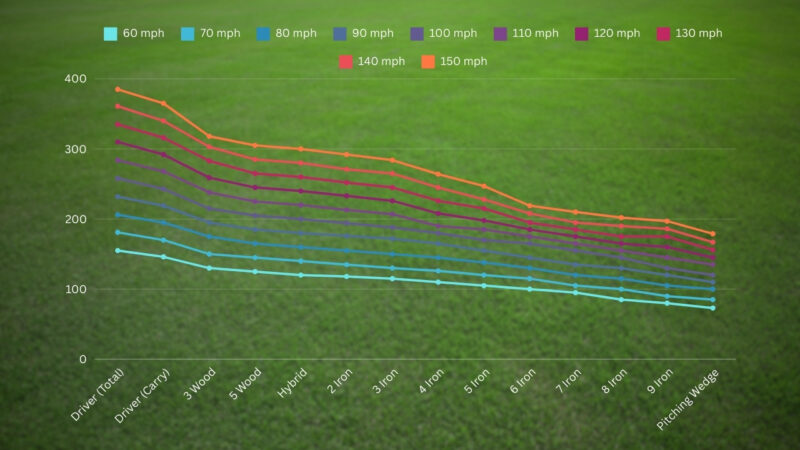
| Club | 60 mph | 70 mph | 80 mph | 90 mph | 100 mph | 110 mph | 120 mph | 130 mph | 140 mph | 150 mph |
|---|---|---|---|---|---|---|---|---|---|---|
| Driver (Total) | 155 | 181 | 206 | 232 | 258 | 284 | 310 | 335 | 361 | 385 |
| Driver (Carry) | 146 | 170 | 195 | 219 | 243 | 268 | 292 | 316 | 340 | 365 |
| 3 Wood | 130 | 150 | 175 | 195 | 215 | 238 | 259 | 283 | 303 | 318 |
| 5 Wood | 125 | 145 | 165 | 185 | 205 | 225 | 245 | 265 | 285 | 305 |
| Hybrid | 120 | 140 | 160 | 180 | 200 | 220 | 240 | 260 | 280 | 300 |
| 2 Iron | 118 | 135 | 155 | 176 | 194 | 213 | 233 | 252 | 271 | 292 |
| 3 Iron | 115 | 130 | 150 | 172 | 188 | 207 | 226 | 245 | 265 | 284 |
| 4 Iron | 110 | 126 | 145 | 165 | 180 | 190 | 208 | 226 | 245 | 264 |
| 5 Iron | 105 | 120 | 138 | 155 | 170 | 185 | 198 | 215 | 228 | 247 |
| 6 Iron | 100 | 115 | 130 | 145 | 165 | 175 | 185 | 195 | 208 | 219 |
| 7 Iron | 95 | 105 | 120 | 135 | 155 | 165 | 175 | 185 | 195 | 210 |
| 8 Iron | 85 | 100 | 115 | 130 | 145 | 155 | 165 | 175 | 190 | 202 |
| 9 Iron | 80 | 90 | 105 | 120 | 130 | 145 | 160 | 175 | 186 | 197 |
| Pitching Wedge | 73 | 85 | 100 | 110 | 120 | 135 | 145 | 156 | 167 | 179 |
How Can I Increase My Swing Speed?
Here are three primary methods to help you swing faster:
- Professional Swing Coaching: Consider working with a professional swing coach who can provide lessons on the correct mechanics. They will tailor your technique based on your physical capabilities, ensuring you maximize your potential. Proper coaching can lead to hitting the golf ball in the center of the clubface, potentially adding up to 10 mph to your driver swing speed.
- Physical Training: Building strength and enhancing mobility through targeted exercises in the gym can contribute to a faster swing. Engaging in strength training along with mobility workouts can extend your range of motion and translate muscle power into increased swing speed. Depending on your starting fitness level, this could add 10-20 mph to your swing.
- Optimized Equipment: Using lighter golf clubs tailored to your swing can increase your swing speed by 2-5 mph. Golf equipment fitted to your specific playing style ensures that you can handle the clubs more efficiently.
What Is the Smash Factor?
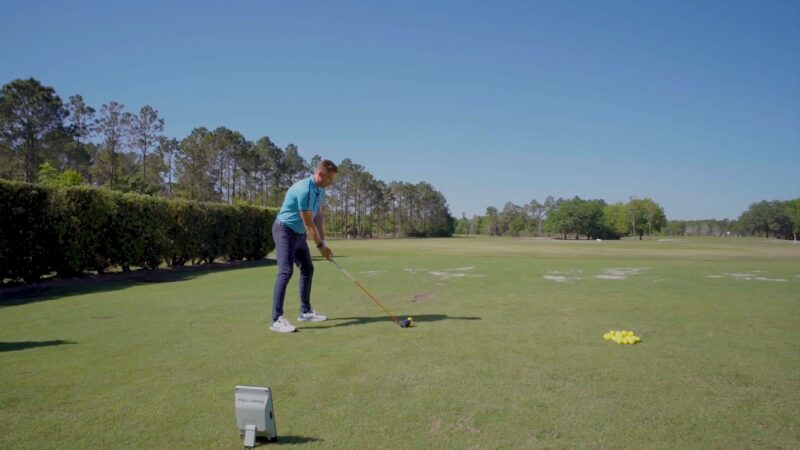
The smash factor is a metric that gauges the efficiency of energy transfer from the golf club to the ball upon impact.
It is calculated by dividing the ball speed by the club speed.
A higher smash factor indicates better energy transfer, resulting in more distance.
Ideal Smash Factor for Different Clubs
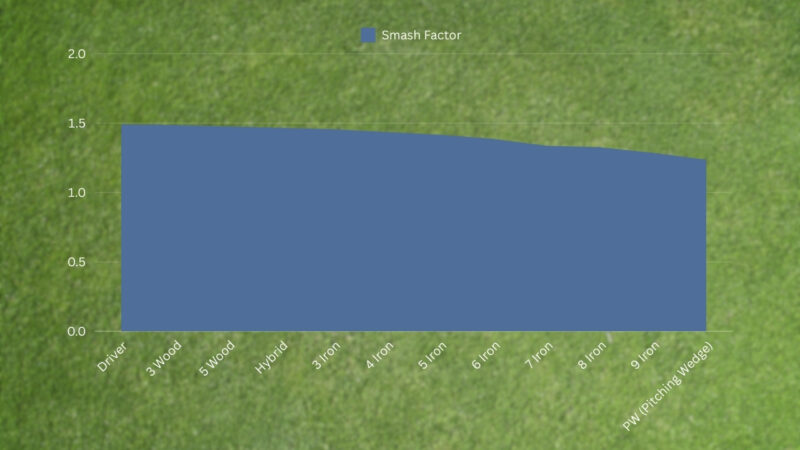
For optimal performance, the PGA Tour averages offer a benchmark for smash factors.
According to Trackman, the ideal smash factor varies by club:
| Club | Smash Factor |
|---|---|
| Driver | 1.49 |
| 3 Wood | 1.48 |
| 5 Wood | 1.47 |
| Hybrid | 1.46 |
| 3 Iron | 1.45 |
| 4 Iron | 1.43 |
| 5 Iron | 1.41 |
| 6 Iron | 1.38 |
| 7 Iron | 1.33 |
| 8 Iron | 1.32 |
| 9 Iron | 1.28 |
| PW (Pitching Wedge) | 1.23 |
These values decline slightly as the loft increases. Achieving these numbers means you are efficiently striking the ball, akin to professional golfers.
Player Skill Level Influences Smash Factor
Where the ball contacts the clubface impacts energy transfer efficiency.
Coaches often help players achieve better smash factor by training them to hit the ball closer to the center of the clubface.
This focus not only improves consistency but also maximizes the potential of the existing swing speed, as measured by the smash factor.
Equipment’s Impact on Swing Speed and Smash Factor
This customization allows them to achieve greater distances even with similar swing speeds to amateurs. Utilizing specially fitted clubs enables pros to optimize their energy transfer.
An equipment fitting can provide similar benefits for amateur players, aligning their gear with their physical attributes and swing mechanics for improved performance.
Average Golf Club Distance for Male Golfers by Skill Level
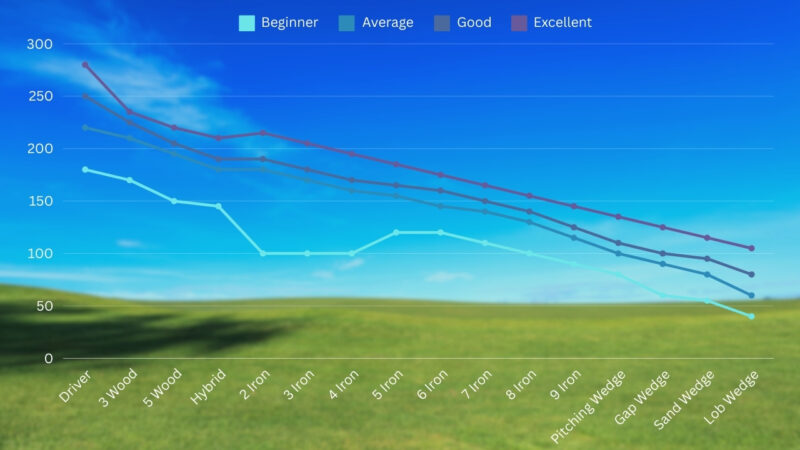
- Beginner golfers, those who are new to the game with only 6-12 months of experience, usually have the shortest ranges. For instance, a beginner typically hits a driver around 180 yards and a pitching wedge approximately 80 yards.
- Average golfers, generally holding a 15-24 handicap, see slightly better distances as their skills develop. They often achieve about 220 yards with a driver and around 100 yards with a pitching wedge. For fairway woods, like the 3 wood and the 5 wood, they achieve distances of 210 yards and 195 yards, respectively.
- Good golfers, with handicaps between 6 and 14, show further improvement. Confidence and technique play pivotal roles here, allowing them to achieve distances like 250 yards with a driver. They can also hit a 5 iron around 165 yards and a hybrid about 190 yards.
- Excellent golfers who possess a handicap below 6 demonstrate the highest proficiency. They achieve long distances with consistency, hitting drivers up to 280 yards and pitching wedges around 135 yards. Even their long irons, such as the 2 iron, reach impressive distances of approximately 215 yards.
| Club | Beginner | Average | Good | Excellent |
|---|---|---|---|---|
| Driver | 180 yds | 220 yds | 250 yds | 280 yds |
| 3 Wood | 170 yds | 210 yds | 225 yds | 235 yds |
| 5 Wood | 150 yds | 195 yds | 205 yds | 220 yds |
| Hybrid | 145 yds | 180 yds | 190 yds | 210 yds |
| 2 Iron | 100 yds | 180 yds | 190 yds | 215 yds |
| 3 Iron | 100 yds | 170 yds | 180 yds | 205 yds |
| 4 Iron | 100 yds | 160 yds | 170 yds | 195 yds |
| 5 Iron | 120 yds | 155 yds | 165 yds | 185 yds |
| 6 Iron | 120 yds | 145 yds | 160 yds | 175 yds |
| 7 Iron | 110 yds | 140 yds | 150 yds | 165 yds |
| 8 Iron | 100 yds | 130 yds | 140 yds | 155 yds |
| 9 Iron | 90 yds | 115 yds | 125 yds | 145 yds |
| Pitching Wedge | 80 yds | 100 yds | 110 yds | 135 yds |
| Gap Wedge | 60 yds | 90 yds | 100 yds | 125 yds |
| Sand Wedge | 55 yds | 80 yds | 95 yds | 115 yds |
| Lob Wedge | 40 yds | 60 yds | 80 yds | 105 yds |
Swing Speed Charts by Age and Gender
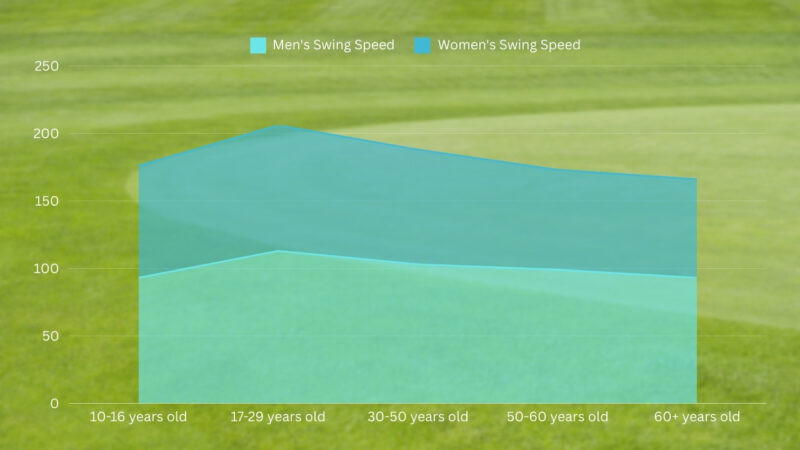
| Age | Men’s Swing Speed | Women’s Swing Speed |
|---|---|---|
| 10-16 years old | 93 mph | 83 mph |
| 17-29 years old | 113 mph | 93 mph |
| 30-50 years old | 103 mph | 85 mph |
| 50-60 years old | 99 mph | 74 mph |
| 60+ years old | 93 mph | 73 mph |
Professional players, who often hit the ball in the center of the clubface, achieve significantly longer distances compared to amateurs with similar swing speeds. Improving accuracy and striking closer to the middle of the clubface can enhance distance, even without an increase in swing speed.
The average swing speed figures above, derived from research by TPI, reflect the 50th percentile for both genders across various age groups, providing a useful benchmark for understanding how age and gender affect swing performance.
FAQ
Is a 250 Yard Drive Good?
Yes, a 250-yard drive is excellent. According to data from Arccos and Shotscope, only between 15% and 31% of golfers can achieve drives of 250 yards or more. A drive of this distance demonstrates a high level of skill and swing speed.
| Skill Level | Swing Speed | Driver Distance |
|---|---|---|
| Beginner | 80 mph | 190 yards |
| Average | 94 mph | 220 yards |
| Good | 100 mph | 240 yards |
| Excellent | 110 mph | 265 yards |
| PGA Tour Average | 114 mph | 275 yards |
| Women’s Average | 77 mph | 180 yards |
| LPGA Tour Average | 94 mph | 218 yards |
Confidence and skill levels significantly impact driving efficiency and accuracy. Beginners typically struggle with mechanics and confidence, leading to lower swing speeds and shorter distances. Mid-handsappers, having more experience or lessons, improve in these areas.
Advanced golfers benefit from extensive practice and professional coaching. Their consistent practice and professional lessons hone their technique and increase their driving distance. At the pinnacle, PGA Tour golfers have optimized every facet of their drive, consistently achieving top performance.
Which Swing Speed Achieves 250-Yard Drives?
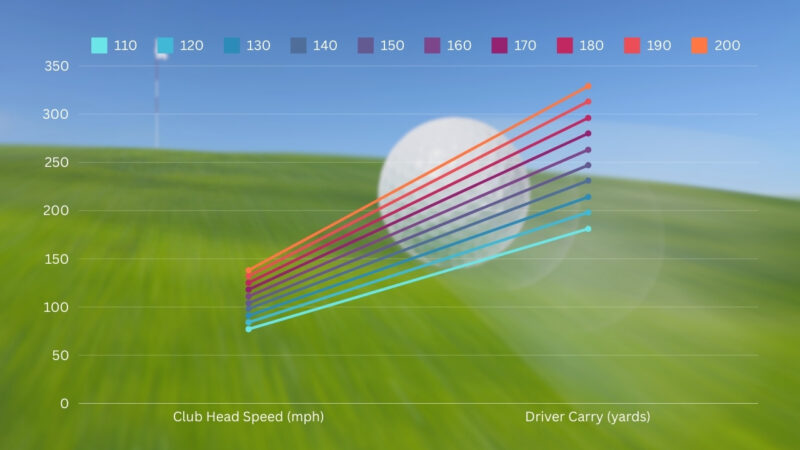
A swing speed around 105 mph with the driver, paired with a ball speed of about 150 mph, typically results in a 250-yard drive.
Ball Speed to Club Head Speed Table Based on Smash Factor of 1.42
| Ball Speed (mph) | 110 | 120 | 130 | 140 | 150 | 160 | 170 | 180 | 190 | 200 |
|---|---|---|---|---|---|---|---|---|---|---|
| Club Head Speed (mph) | 77 | 84 | 91 | 98 | 104 | 111 | 118 | 125 | 132 | 138 |
| Driver Carry (yards) | 181 | 198 | 214 | 231 | 247 | 263 | 280 | 296 | 313 | 329 |
Good striking or smash factor is crucial for maximizing distance. This table demonstrates how different club head speeds and ball speeds interact to produce varying distances with drivers.
What Swing Speed Hits the 7 Iron 150 Yards?
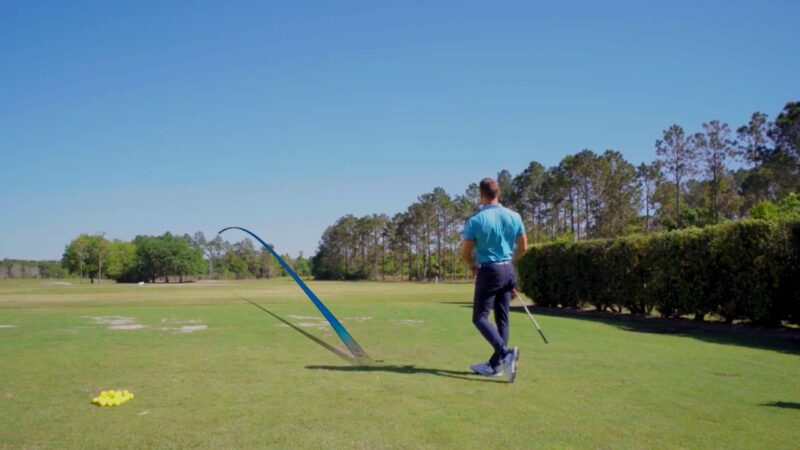
Achieving a 150-yard carry shot with a 7 iron involves a precise combination of swing speed, ball speed, and dynamic loft. Specifically, a swing speed of around 76 mph, resulting in a ball speed of approximately 105 mph, along with a dynamic loft of 21°, will produce the desired distance.
| Swing Speed (mph) | Distance (yards) |
|---|---|
| 60 | 95 |
| 70 | 105 |
| 80 | 120 |
| 90 | 135 |
| 100 | 155 |
| 110 | 165 |
| 120 | 175 |
| 130 | 185 |
| 140 | 195 |
| 150 | 210 |
This table provides a clear reference for understanding the relationship between swing speed and distance, helping golfers optimize their performance.

